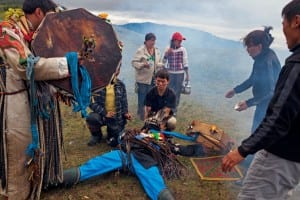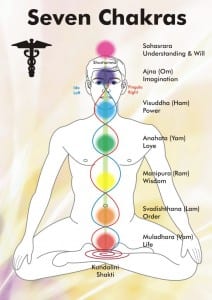Understand Shamanism
- a traditional way of healing patient and a way of life which always connect human with the nature.
- important aspects include journeying, sacred dance, ceremony and pilgrimage to places of power in nature.
- to unify lives with strength, love and heal.
Shaman – intermediary between world and spirit world, conduct ceremonial ritual, healing people.
* in Kelantan (a state in Malaysia), the malay culture also practice a shaman-like tradition which they call in Main Putri. Another form called Mak Yung also has similar function to heal sick people.
* in Chinese culture, we also have shaman-like practices mostly in the temple. We call this ritual ‘Ji Tong’. Below is the link about ‘Ji Tong’:
http://www.taiwanese-secrets.com/ancient-chinese-ritual.html
Developmental Transformation – drama therapy method, transformations embodied, playspace/scared space
- Extraction抽取 – procedure where shamans cut, suck and pull out the bad energy/ ‘entities’冤魂 out from the patient.
Shamans think they are providing dramatic structure for the client to transform energy.
Shapeshifting – good acting
DvT therapist and client are shapeshifter all the time. Therapist shapeshifting into other character to represent client’s inner world.
Dreaming & Journeying – Shamans believed that important message always deliver through dreams. While journeying enhanced by singing, dancing, use of drug or/and constant beat of drum, is a practice of consciousness ”becoming the spirit world which shaman will travel”
Developmental Transformations therapist is to guide to playspace (is a form of trance), where shamans (used the word trance to describe shamanic state of consciousness) guide to sacred place. Both of them have similarity and aim to cure sickness people mostly to people who have emotional problem.
- Surrender to ”illud tempus’ is one of the technique used by shaman to bring healing environment to client.
Question: Is it like follow the instinct??
Knowing Chakras.
Developmental Transformation
DvT is a drama psychotherapy which you need to understand the process and dynamics of Freeplay. Based on theoretical idea of Jerzy Grotowski 1968.
4 components:
1. TRANSFORMATION –
- The essential proposition of Dvt is that Being is unstable.
- world is turbulence. Turbulence动荡 give emanation化身/发出, emanation gives development, and development, transformation = Developmental Transformations.
2. EMBODIMENT – We arise into this world as Body, with consciousness being its energetic limb and our physical body being its material limb. Its first manifestation is simply Presence, with its turbulent but minimal form. The next manifestation may be called Body as Desire, in that our presence coalesces into impulse and desire. Next is Body as Persona, in which our experience and desires form further into notions of Self and Person. (In this sense, DvT is also aligned with the third of Buddhism’s Three Signs: that the Self is a composite of impersonal elements). Finally, our emanation forms further into Body as Other, in which we organize ourselves in the larger world and clothe ourselves with social roles and identities.
Life is unstable. People always trying to re-shape, undo, change, or hide our body, fear of conflict.
BODY
PRESENCE > DESIRE > PERSONA (SELF) > OTHER ( put on social role, identity, clothe…)
- DvT also aim to let oneself learn to have ability to be located by the Other, able to play with consciousness in ourselves.
- DvT emphasis this on Embodiment.
3. ENCOUNTER 遇见,领教,邂逅 – to be proximity接近 to other people, encountering another people.
Our fears over Change and impermanence, over our Presence as a Body, and over our proximity to Others are the three significant existential challenges we face, and that DvT attempts to address.
4. PLAYSPACE – is the entire therapeutic action. It includes 3 component:
A. Restraint against harm – understand the intension is to reveal harm/evil, not to commit it.
B. Discrepant (differ不符)communication – mark the boundary between fantasy and reality. It required less discrepancy in their
communication to maintain the playspace.
C. Mutual agreement – playspace is an inter-subjective experience mutually understood by all parties. Mutual relationship.
Important aspects :
1. dramatic and improvisational interactive between therapist & client
2. therapist (active participant) intervenes (interfere) through his/her immerse浸泡 of the client’s playspace.
3. the play process is to loosen, remove psychic (spiritual) structure that inhibit on the client.
4. the treatment is believed to lead to greater emotional health.
I hope to understand better from these texts. I thought there are some important points in it.
”It can be imagined that the Self has a similar structure like the earth: its surface has the appearance of solidity, but is in fact constantly changing; its crust, made up of large tectonic narratives, is used to locate oneself in the cool social world within which we live; our identity is constructed of these roles which form what we call our persona. Yet underneath there remains the pressure of Desire, and at our center, let us call it the Source, is a turbulent, heated core, without form. To some, the absence of form at our center is a reason to proclaim that we have no core. But if we have no core, what then is this which rises up? The pathway through which the Source emerges within us is our Body. By Body we mean both our physical and energetic presence. Thus, as the Source is expressed, it cools and forms into desires and impulses, thoughts and perceptions, images of self and other, roles and identities. Health is understood to be the continued natural unfolding of this developmental process. Ill health is understood to be the stifling of this process when already-created forms block the emergence of new forms. This is often due to protective responses to painful encounters with other human beings. The result is a division among Other, Self, and Source.
Developmental Transformations intends to facilitate a renewed flow or link between Source, Self, and Other (not a withdrawal from others or attainment of a selfless state). It does so through the use of free play as a tool for continuous transformation. As one experiences embodiment, opens oneself to the encounter with others, and embraces continuous change (i.e., play), one finds oneself reconnected to one’s Source. This is what we mean by Presence.”
Meditation
3 ways of approach meditation:
1. Medical – basically for health and reduce sickness.
2. Martial – a relaxing technique use to enhance performance and creativity. Including athlete, dancer, musician and actor to improve their skills in performance.
3. Spiritual – spirituality is aliveness. The goal is to find balance between heart, mind and body/ body & soul.
Trance
- common human experience.
- engage in constant momentary forays into a dreamlike state.
- accept and embrace those dreamlike and more visionary moment in order to be trance.
- images and emotions will arise while trance but those are like dreams, but they contain valuable information. It can helps to enhance our live.
Many faces of Trance
”Trance is a temporary suspension of the reality filters of the conscious mind, and
an experiential absorption into the quantum量 world of the creative unconscious.”
Trance Dance
- better to move in repetitive movements because it is more trance provoking.
- listen and follow the body.
My Own Practises
Sitting Meditation:
I have tried a 15 minutes of sitting meditation in my bedroom. My focus was on my breathing and I kept thinking of the words inhale and exhale. At the same time try not to think any other thing, but it was not easy to keep the mind empty where some moment some images and thought crossed my mind. Then my back and neck felt tired and pain, I can feel my chest getting heavier. I felt hard to breathe at some point and I kept shifting breathing using my nose and my mouth. The last 5 minutes I felt a bit of dizziness in my head.
The experience was not too unfamiliar because I have practiced similar exercise during my yoga classes.
Trance Dance:
I have chosen one meditation trance drumming music from Youtube. Set my stopwatch as 30 minutes. When the music started, I closed my eyes to feel the music and the beat and tried to focus on my body. I started to move my body but to be honest, it was not naturally and organic. It was my mind forced my body to start dancing. It was like a dance improvisation to me. Because of I am a dancer, my mind kept thinking and observing the movements I were doing. I felt dizzy again. I stopped after 15 minutes rather than 30 minutes. Maybe I were not ready for it, or maybe not in liminal mode.
Breathing Meditation
I sit outside of the house, on a wooden floor and started practising yoga breathing exercise. I do not remember the name of the exercise. The first one I did was the most basic one which was inhale with the nose as long as possible and hold for 3 second, then exhale with mouth slowly. I repeated the set about 10 minutes then I proceeded to another one which was pressing the right nostril with left ring finger and inhale. Hold for 3 second, press the left nostril with left thumb and exhale. Repeat it with the other way around. I did the exercise for 10 minutes. The third breathing exercise was inhale once, then exhale with the mouth with sound for 30 times and focus on the movement of abdomen. Finish with normal breathing. I repeated the exercise for 3 times.
I felt more relief after doing this meditation and I believe it can helps to clear our mind.
I continued with some simple yoga exercise to make my body stretch and practice on using the right energy.
Answers:
2. According to Melanin Klein, Self is built up out of Other’s perceptions of us. Perceiving the gaze from other people, and we feel constrained约束. In DvT, Plot keep an order to time, Character orders self, Story keeps predictability of ending. Client and therapist allow themselves to be with each other with less intermediary veils中介面纱 and start to built trust.
3. In this modern world, shamanism has been combined with therapy for healing purpose. There is similarities between shamanism and DvT.
4. According the texts in CS1, body is a medium and it can reveal politic. It also become the site to present artist’s work. In Developmental Transformation, body also used as the medium and site to reveal but to show the real of ourselves in positive and negative side in order to allow therapist help us in different aspect.
In CS1, for example live art performances sometimes or most of the time performers remark identity. Similar to DvT where the therapist will provide a character for the client, where client have to shift their identity into the given character.

